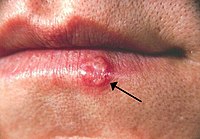
Photo from wikipedia
Series of poly(ethylene glycol)-block-poly(3-(methacryloylamino)propyl trimethylammonium chloride) (PEG-b-PMAPTAC) water-soluble block copolymers consisting of poly(ethylene glycol) (PEG) and poly(3-(methacryloylamino)propyl trimethylammonium chloride) (PMPTAC) were obtained by reversible addition-fragmentation chain-transfer (RAFT) polymerization and demonstrated… Click to show full abstract
Series of poly(ethylene glycol)-block-poly(3-(methacryloylamino)propyl trimethylammonium chloride) (PEG-b-PMAPTAC) water-soluble block copolymers consisting of poly(ethylene glycol) (PEG) and poly(3-(methacryloylamino)propyl trimethylammonium chloride) (PMPTAC) were obtained by reversible addition-fragmentation chain-transfer (RAFT) polymerization and demonstrated to function as highly effective herpes simplex virus type 1 (HSV-1) inhibitors as shown by in vitro tests (Vero E6 cells) and in vivo experiments (mouse model). Half maximal inhibitory concentration (IC50) values were determined by qPCR to be 0.36 ± 0.08 µg/ml for the most effective polymer PEG45-b-PMAPTAC52 and 0.84 ± 1.24 µg/ml for the less effective one, PEG45-b-PMAPTAC74. The study performed on the mouse model showed that the polymers protect mice from lethal infection. The polymers are not toxic to the primary human skin fibroblast (HSF) cells up to the concentration of 100 μg/m and to the Vero E6 cells up to the 500 μg/ml. No systemic or topical toxicity was observed in vivo, even with mice treated with concentrated formulation (100 mg/ml). The mechanistic studies indicated that polymers interacted with the cell and blocked the formation of the entry/fusion complex. Physicochemical and biological properties of PEGx-b-PMAPTACy make them promising drug candidates.
Journal Title: ACS applied materials & interfaces
Year Published: 2019
Link to full text (if available)
Share on Social Media: Sign Up to like & get
recommendations!